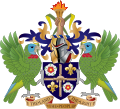Queen of Saint Lucia
| Queen of Saint Lucia | |
|---|---|

|
|
| Incumbent | |
 |
|
| Elizabeth II | |
| Details | |
| Style | Her Majesty |
| Heir apparent | Charles, Prince of Wales |
| First monarch | Elizabeth II |
| Formation | 22 February 1979 |
The monarchy of Saint Lucia is a system of government in which a hereditary, constitutional monarch is the sovereign of Saint Lucia. The present monarch of Saint Lucia is Elizabeth II, who is also the Sovereign of the Commonwealth realms. The Queen's constitutional roles are mostly delegated to the Governor-General of Saint Lucia.
Royal succession is governed by the English Act of Settlement of 1701, which is part of constitutional law.
The present queen Elizabeth II has reigned over the separate Saint Lucian monarchy since 22 February 1979. She along with her husband and other members of the Royal Family undertake various official, ceremonial and representational duties.
Fifty-three states are members of the Commonwealth of Nations. Sixteen of these countries are specifically Commonwealth realms who recognise, individually, the same person as their Monarch and Head of State; Saint Lucia is one of these. Despite sharing the same person as their respective national monarch, each of the Commonwealth realms – including Saint Lucia – is sovereign and independent of the others.
As a constitutional monarch Queen Elizabeth II entirely on the advice of her Saint Lucian ministers. The monarch is briefed by regular communication for her Saint Lucian government. Most of the Queen's daily constitutional roles are mostly delegated to the Governor-General of Saint Lucia.
The governor general is appointed entirely upon the advice of her Saint Lucian government. The monarch maintains direct contact with the governor general. The present Governor-General is Her Excellency Dame Pearlette Louisy GCMG.
Control of St Lucia was disputed between the British and French from 1659 until 1814 when it was ceded to the British.
The Balfour Declaration of 1926 provided the dominions the right to be considered equal to Britain, rather than subordinate; an agreement that had the result of, in theory, a shared Crown that operates independently in each realm rather than a unitary British Crown under which all the dominions were secondary. The Monarchy thus ceased to be an exclusively British institution, although it has often been called "British" since this time (in both legal and common language) for reasons historical, legal, and of convenience. The Royal and Parliamentary Titles Act, 1927 was the first indication of this shift in law, further elaborated in the Statute of Westminster, 1931.
...
Wikipedia
